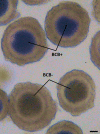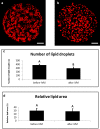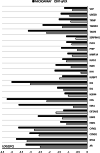Genes regulating hormone stimulus and response to protein signaling revealed differential expression pattern during porcine oocyte in vitro maturation, confirmed by lipid concentration
- PMID: 32189110
- PMCID: PMC7343741
- DOI: 10.1007/s00418-020-01866-w
Genes regulating hormone stimulus and response to protein signaling revealed differential expression pattern during porcine oocyte in vitro maturation, confirmed by lipid concentration
Abstract
Genes influencing oocyte maturation may be valuable for predicting their developmental potential, as well as discerning the mechanistic pathways regulating oocyte development. In the presented research microarray gene expression analysis of immature and in vitro matured porcine oocytes was performed. Two groups of oocytes were compared in the study: before (3 × n = 50) and after in vitro maturation (3 × n = 50). The selection of viable oocytes was performed using the brilliant cresyl blue (BCB) test. Furthermore, microarrays and RT-qPCR was used to analyze the transcriptome of the oocytes before and after IVM. The study focused on the genes undergoing differential expression in two gene-ontology groups: "Cellular response to hormone stimulus" and "Cellular response to unfolded protein", which contain genes that may directly or indirectly be involved in signal transduction during oocyte maturation. Examination of all the genes of interest showed a lower level of their expression after IVM. From the total number of genes in these gene ontologies ten of the highest change in expression were identified: FOS, ID2, BTG2, CYR61, ESR1, AR, TACR3, CCND2, EGR2 and TGFBR3. The successful maturation of the oocytes was additionally confirmed with the use of lipid droplet assay. The genes were briefly described and related to the literature sources, to investigate their potential roles in the process of oocyte maturation. The results of the study may serve as a basic molecular reference for further research aimed at improving the methods of oocyte in vitro maturation, which plays an important role in the procedures of assisted reproduction.
Keywords: Microarray; Mitochondrial activity; Oocyte maturation; Pig.
Conflict of interest statement
The authors declare no conflict of interest.
Figures











Similar articles
-
Transcriptomic Pattern of Genes Regulating Protein Response and Status of Mitochondrial Activity Are Related to Oocyte Maturational Competence-A Transcriptomic Study.Int J Mol Sci. 2019 May 7;20(9):2238. doi: 10.3390/ijms20092238. Int J Mol Sci. 2019. PMID: 31067669 Free PMC article.
-
Expression pattern of new genes regulating female sex differentiation and in vitro maturational status of oocytes in pigs.Theriogenology. 2018 Nov;121:122-133. doi: 10.1016/j.theriogenology.2018.08.019. Epub 2018 Aug 18. Theriogenology. 2018. PMID: 30145542
-
"Bone Development" Is an Ontology Group Upregulated in Porcine Oocytes Before In Vitro Maturation: A Microarray Approach.DNA Cell Biol. 2017 Aug;36(8):638-646. doi: 10.1089/dna.2017.3677. Epub 2017 Jun 2. DNA Cell Biol. 2017. PMID: 28574720
-
The utility of Brilliant Cresyl Blue (BCB) staining of mammalian oocytes used for in vitro embryo production (IVP).Reprod Biol. 2013 Sep;13(3):177-83. doi: 10.1016/j.repbio.2013.07.004. Epub 2013 Jul 20. Reprod Biol. 2013. PMID: 24011188 Review.
-
Despite the donor's age, human adipose-derived stem cells enhance the maturation and development rates of porcine oocytes in a co-culture system.Theriogenology. 2018 Jul 15;115:57-64. doi: 10.1016/j.theriogenology.2017.12.024. Epub 2017 Dec 12. Theriogenology. 2018. PMID: 29709724 Review.
Cited by
-
Oocyte maturation abnormalities - A systematic review of the evidence and mechanisms in a rare but difficult to manage fertility pheneomina.Turk J Obstet Gynecol. 2022 Mar 28;19(1):60-80. doi: 10.4274/tjod.galenos.2022.76329. Turk J Obstet Gynecol. 2022. PMID: 35343221 Free PMC article.
-
Progesterone Induces Apoptosis and Steroidogenesis in Porcine Placental Trophoblasts.Animals (Basel). 2022 Oct 8;12(19):2704. doi: 10.3390/ani12192704. Animals (Basel). 2022. PMID: 36230445 Free PMC article.
-
Smart-seq2 Technology Reveals a Novel Mechanism That Zearalenone Inhibits the In Vitro Maturation of Ovine Oocytes by Influencing TNFAIP6 Expression.Toxins (Basel). 2023 Oct 17;15(10):617. doi: 10.3390/toxins15100617. Toxins (Basel). 2023. PMID: 37888648 Free PMC article.
-
A cell transcriptomic profile provides insights into adipocytes of porcine mammary gland across development.J Anim Sci Biotechnol. 2023 Oct 8;14(1):126. doi: 10.1186/s40104-023-00926-0. J Anim Sci Biotechnol. 2023. PMID: 37805503 Free PMC article.
References
-
- Artini PG, Tatone C, Sperduti S, D’Aurora M, Franchi S, Di Emidio G, Gatta V, et al. Cumulus cells surrounding oocytes with high developmental competence exhibit down-regulation of phosphoinositol 1, 3 kinase/protein kinase B (PI3K/AKT) signalling genes involved in proliferation and survival. Hum Reprod. 2017;32(12):2474–2484. doi: 10.1093/humrep/dex320. - DOI - PMC - PubMed
-
- Blaha M, Nemcova L, Kepkova KV, Vodicka P, Prochazka R. Gene expression analysis of pig cumulus-oocyte complexes stimulated in vitro with follicle stimulating hormone or epidermal growth factor-like peptides. Reprod Biol Endocrinol. 2015;13(1):113. doi: 10.1186/s12958-015-0112-2. - DOI - PMC - PubMed
-
- Borys-Wójcik S, Kocherova I, Celichowski P, Popis M, Jeseta M, Bukowska D, Kempisty B, et al. Protein oligomerization is the biochemical process highly up-regulated in porcine oocytes before in vitro maturation (IVM) Med J Cell Biol. 2018;6(4):155–162. doi: 10.2478/acb-2018-0025. - DOI
-
- Borys S, Brązert M, Jankowski M, Kocherova I, Ożegowska K, Celichowski P, Kempisty B, et al. Enzyme linked receptor protein signaling pathway is one of the ontology groups that are highly up-regulated in porcine oocytes before in vitro maturation. J Biol Regul Homeost Agents. 2018;32(5):21–35. - PubMed
MeSH terms
Substances
Grants and funding
LinkOut - more resources
Full Text Sources
Medical
Research Materials
Miscellaneous

